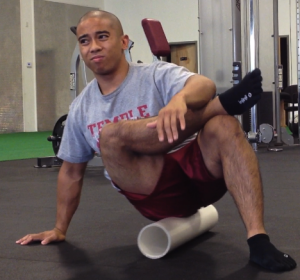There are generally three goals within the fitness industry: improve athletic performance, reset or inhibit neurological dysfunction, or reduce fat throughout your body. All of these approaches may require many many many different types of techniques and methods. One common bond that unites all of these goals can involve some sort of exercise.
Admittedly, using a foam roller may not be necessary in order to progress towards these goals. So from the get-go, you don’t need to utilize this tool in order to benefit towards your goals. But if you plan on doing something involving exercise, it can possibly benefit you. Or it might not. It is up to you to use it! :)
If I can increase core activation, increase blood flow to local muscle beds, and increase proprioceptive receptor input before even getting into the meat of any training program, it’s likely that I’m going to achieve it with foam rolling.
On a related note, I think that foam rolling is not a substitute to the work that a smart manual therapist can provide – my opinion entails that foam rolling is nothing more than superficially rolling on muscle and fascia. Whether or not I’m affecting what is happening within the bed of the muscle is not my aim – it is to achieve all of the above!
Here are links to videos going through the process of self-myofascial release with other implements such as the Back Knobber, medicine balls, and lacrosse (LAX) balls for various parts of the body. The following are specific areas that bboys and other dancers may find to be particularly “knotted up” when initially rolling.
- Forearm Self-Myofascial Release with LAX Ball
- Palmar Fascia Self-Myofascial Release with Knobber
- Back and Neck Self-Myofascial Release with Knobber
- Adductor Self-Myofascial Release with Med Ball
- Glutes Self-Myofascial Release with LAX Ball
Keep in mind, this is not a substitute for pain relief. I’m very careful with my verbiage around the word pain – my aim is not reduce or get rid of pain, but rather to help reduce tight musculature through various methods, and to eventually clear movement patterns found in the initial movement assessment.

My first time on a foam roller was in 2010, and it was relatively uncomfortable to say the least. After a few years of rolling around before a training session, it is still relatively uncomfortable – depending of course on how much soreness was induced from the previous training session.
They See Me Rollin’…
With new clients and trainees overall, there is a learning curve with understanding the use of a foam roller, and I’d rather take my time teaching someone how to do it correctly for 5-10 minutes, as opposed to them fumbling around on the floor aimlessly.
My initial impression upon using the foam roller has been that “We are manipulating the fascia that surrounds the muscle.” Now, my tune has changed – I’m not sure we can measure or view how the fascia changes after a bout of foam rolling, and maybe even trigger point adaptation was something that I thought foam rolling could alter, as well.
It is more likely that we are changing perception of mechanoreceptors from the superficial surface of the skin on down.
So with that in mind, here are some benefits towards foam rolling…
- Superficial fascial rolling: Fascia is a sheath that surrounds muscle. Fascia can get relatively “gunked” up through chronic and overuse movement patterns. Think of foam rolling as an act that serves to decrease the “gunkiness” of the parts of the muscle that are accessible superficially.
- Inhibition of “tight” muscles: When a muscle such as your hamstrings presents as “tight” there could be a few reasons for this: 1. Position of pelvis, 2. Soft Tissue Quality, and 3. Protective Mechanisms. When I’m looking to reduce someone’s “tight” muscle groups, it is important to take these considerations into account. Inhibiting targeted area will help to reduce these feelings of tightness.
If you are still convinced that foam rolling is not up to snuff, here are logistical and extrapolated benefits:
- Ischemic effect: Sit on a foam roller on your quad for longer than 5 seconds, and perhaps you’ll feel something similar to a “warm sensation” going down your leg. No, you didn’t accidentally relieve yourself. Instead, the idea is that through the “release” of the tight muscles, blood flow could acutely be restored at the local site of the foam rolling. This in turn could restore nutrients to the muscle bed, and good things happen when you restore blood flow to your muscles.
- Crawling effects: While the idea of rolling around and crawling on the ground is actually not new to me at all since I’ve been bboying since I was 14, I merely did it to look cool at a high school dance. Low and behold there are theoretical concepts involving increased feedback to proprioceptive receptors. So when you roll on a foam roller, half of your body is often on the ground just feeding into these receptors. Also, you can increase core activation if done in the correct position, because you essentially have to hold yourself up while rolling around!
- Research indicates that there is an acute increase in range of motion (think flexibility) due to a bout of self-myofascial release. No stretching… but an increase in range of motion…? I’m all about saving ligaments, so let’s do it.
With all of these in mind, I’m probably going to continue foam rolling for quite some time. It simply has too many benefits to ignore, and the only drawback that I can see is if the method is pursued with incorrect intentions (foam rolling to get rid of pain for more than 2+ weeks).
As always…
Keep it funky.


